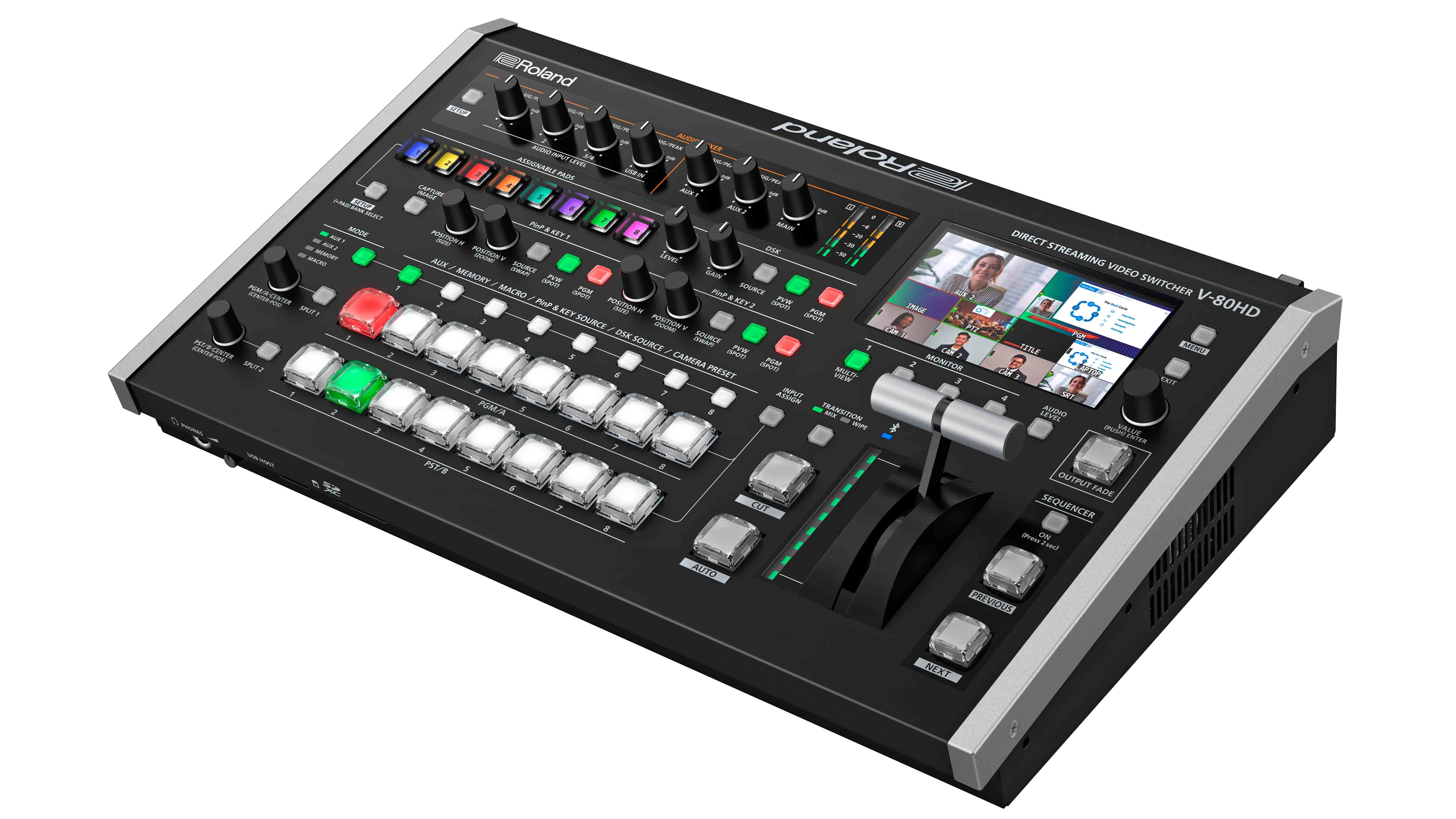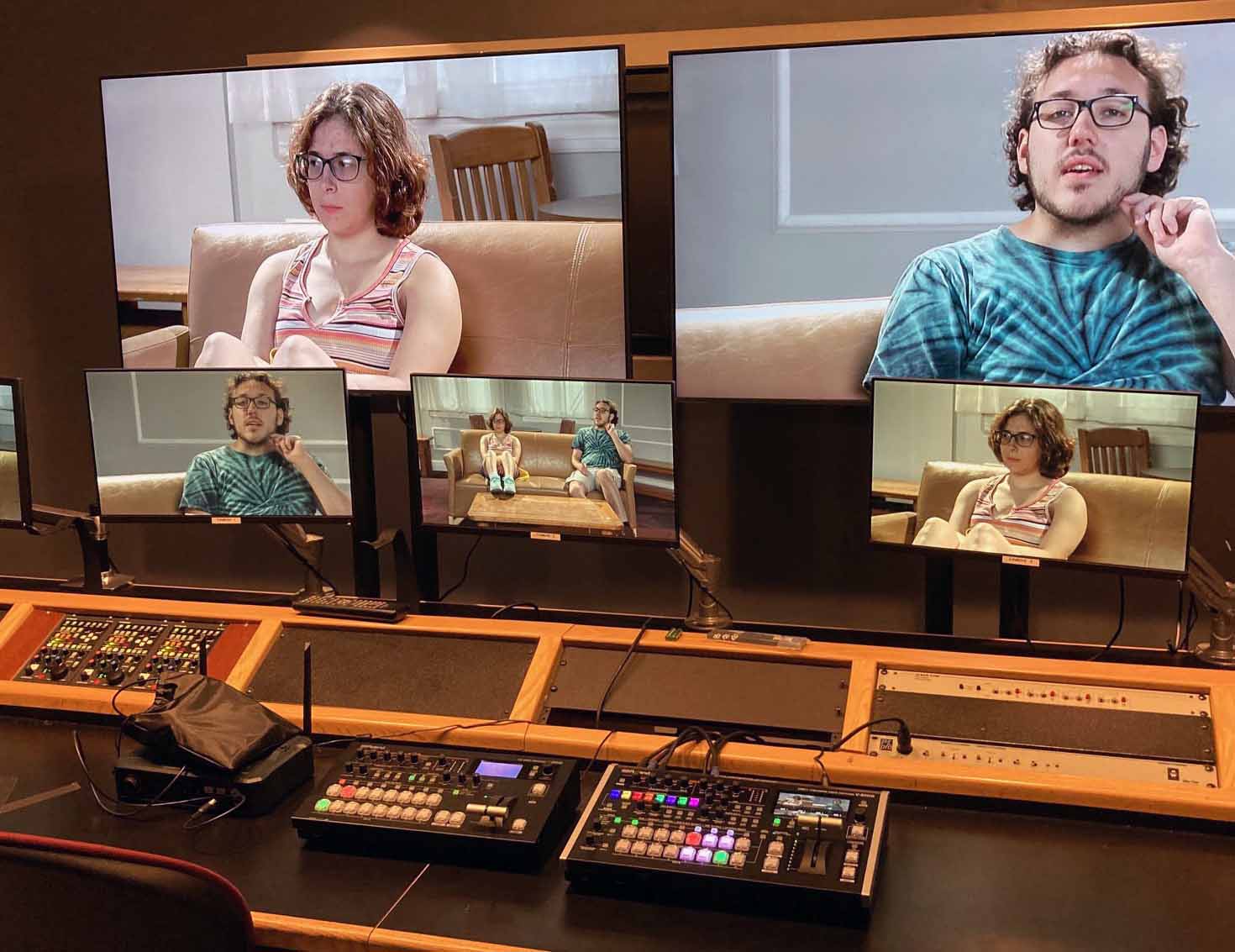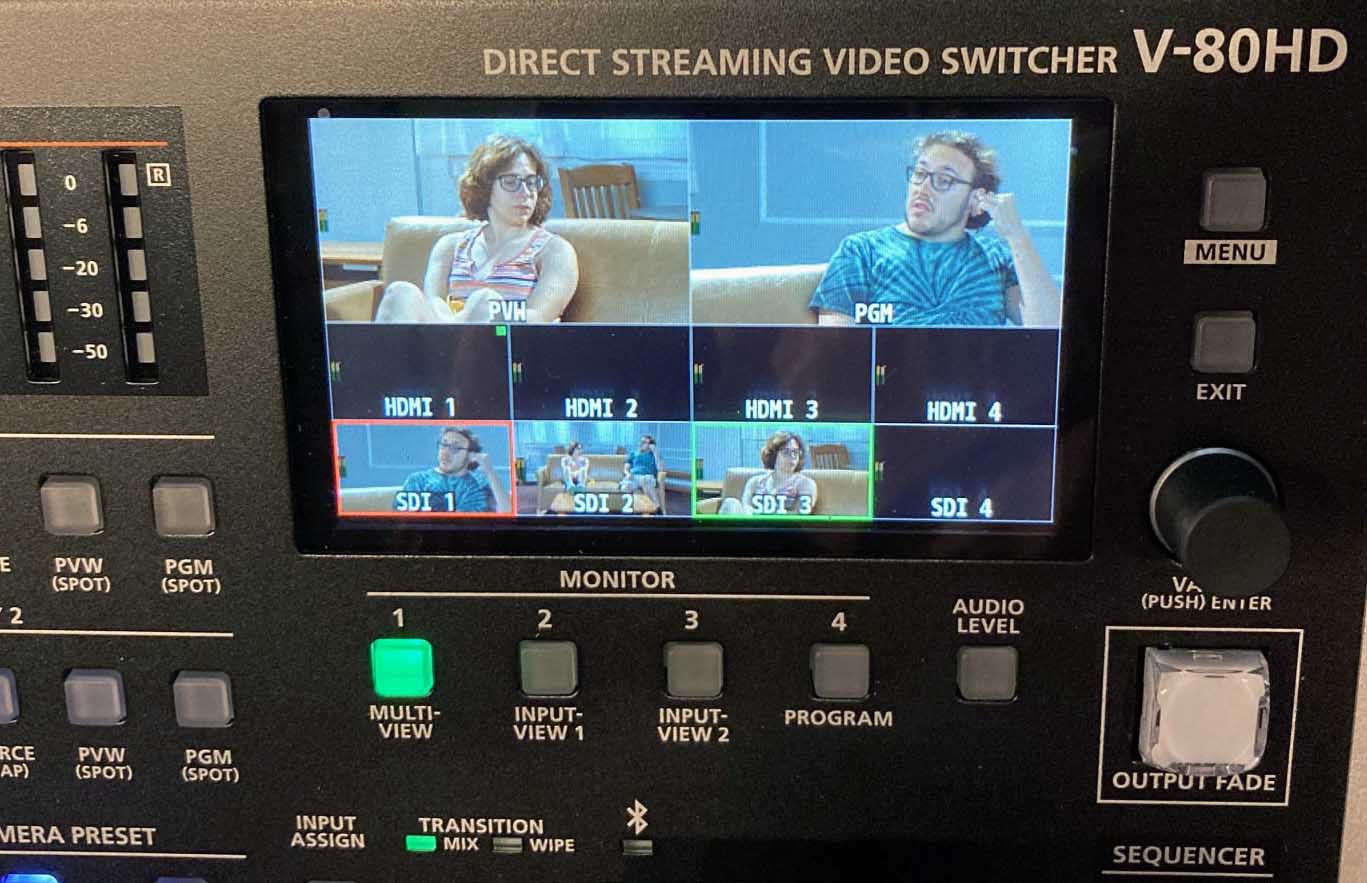Product Review: (Slightly) Bigger Is Better
The new Roland V-80HD makes switching and streaming easy.

We've had the Roland V-60HD as our university’s TV studio video switcher for many years, so I was excited to try the new V-80HD direct streaming video switcher, which Roland announced in June. With a slightly larger footprint (almost 16 inches wide, 10 inches deep, and about 4 inches high), this compact switcher does everything we have come to expect from Roland and much more.
Your Pick of Sources
A switcher is only as good as its I/O. The eight video inputs on the V-80HD offer a mix of HDMI, 3G-SDI, and SRT—so you can use studio cameras, ENGs, even PTZs—while its outputs add USB 3.0 and LAN to the mix. It also supports up to 28 channels of audio and has built-in streaming (SRT, RTMP, and RTMPS protocols). If you're crunched for time, audio and video actions can be pre-programed. And with Mac or Windows based systems, the software allows remote operation.
[Product Review: Keep on Tracking]
The V-80HD supports a wide variety of formats and frame rates, including 4K60. If you’re mixing HD with 4K sources, two of the HDMI inputs will downscale to HD, and frame rate converters within the SDI inputs will simplify your productions by having your sources match.
Output sources are plentiful—HDMI, LAN, SDI, and USB-C. The USB output can send video and sound to a phone, computer, or UVC platform. Use the LAN output for RTMP. If your production requires effects, you can utilize the downstream keyer (DSK), as well as two picture-in-picture windows and split screen. Got a Windows-based system? Graphics and titles can be generated using free templates with the companion Graphics Presenter software and shared with the switcher via an HDMI cable.
The top of the Roland V-80HD features four audio input level pots, two auxes, and a main with peak and left and right level LEDs. Directly below are eight assignable pads, downstream keyer (DSK) with level, gain, source, preview, and program. And below that are picture-in-picture and key control, with both keys offering horizontal and vertical positioning knobs, plus source, preview, and program. The next bank is selectable between Aux 1, Aux 2, memory, and macro. The Program Bank offers eight inputs and preview bank with A-center and B-center adjustments for the spilt screen.

On the top of the right side of the switcher is the integrated 4.3-inch LCD monitor with buttons to let you choose multiview, two input views, and program. You'll also find controls for menu adjustments, output fade, and more. You can select between mix and wipe for the fader bar, plus there are cut and auto transition buttons. Below the front panel is where you'll find the headphone input and volume, plus USB host input and an SDXC card input for storing information.
A daily selection of the top stories for AV integrators, resellers and consultants. Sign up below.
[Integrated Production Switchers: Doing More with Less]
The back of the V-80HD houses the 24-volt DC input, power button, left and right XLR audio outputs, left and right RCA for a third and fourth channel, USB-C (computer or cell phone) and LAN (direct) streaming outputs, three HDMI outputs, four HDMI input scalers (two are 4K scalers with thru ports). Rounding out the ports are RS-232 and tally/GPIO outputs, two CTL/EXP ports, four SDI inputs, and two SDI outputs.
Ready for Action
The Roland V-80HD is so user friendly even the most non-technical person can easily hook it up and have it running in little time. Having an older version of a Roland switcher made our hookup even easier. We have three Hitachi 1080p cameras connected via SDI and a UHD 4K PTZ camera attached via a downscaling HDMI.
Each of our four usable inputs are attached to a 20-inch LED monitor, and the preview and program have their own 55-inch LED monitors. The V-80HD can display all monitor information on one screen, but I chose to keep it the way our control room had operated in the past.

The V-80HD does far more than our V-60HD ever did. After attaching all the SDI and HDMI cables, I powered up the system. The pretty light show lasted a few moments before it settled into its ready mode.
One of our senior TV/Film majors instinctively set up a preset where several of the live camera images animated to their positions. I asked him how he knew how to set up this mildly complicated maneuver. He replied, “My summer job was live streaming using a switcher.” It wasn’t a Roland, but with almost no trial an error, he had it set up.
After seeing his ease with the Roland V-80HD and feeling as if I should have taken a refresher course in Switchers 101, I took the reins and set up a DSK. I must admit it felt great showing my student how to do something he had no clue how to do.
As I had mentioned, switchers have come a long way in their ease of setup and operation. The Roland V-80HD moves to the head of the class; it is just extremely easy to learn and operate. The V-80HD also does so much that it opens the door for more creativity in a studio environment. I really liked the built-in monitor. Having the program image—or all your sources—right in front of you on the switcher is easier than looking all the multitude of monitors throughout the studio.
[Review: Jabra Videobar Is Built for Busy Meetings]
Initially, I thought a bigger switcher wouldn’t be any improvement. I was wrong. The Roland V-80HD is a powerful yet reasonably priced switcher for a TV studio. It has plenty of features and inputs without the steep learning curve of other, more expensive choices. The best quote from a student: “You can teach a course on how this switcher will make live productions less complicated and how this switcher will make our TV shows more exciting.”
Chuck Gloman, Associate Professor, has more than 40 years of experience as a producer and director of photography with more than 900 TV commercials, 250 corporate videos, and 100 documentaries to his credit. His films have aired on HBO, Cinemax, and network television. He is the author of Placing Shadows: The Art of Video Lighting, 2nd Edition (Focal Press: 2000); No Budget Digital Filmmaking (McGraw-Hill: 2002); 303 Digital Filmmaking Solutions (McGraw-Hill: 2002); 202 Digital Photography Solutions (McGraw-Hill: 2003); Placing Shadows: The Art of Video Lighting, 3rd Edition (Focal Press: 2005); Scenic Design and Lighting Techniques (Focal Press: 2006); Working with HDV (Focal Press: 2006); Placing Shadows: The Art of Video Lighting, 3rd Edition (translated in Japanese Language Focal Press: 2007); and Placing Shadows: The Art of Video Lighting, 3rd Edition (translated in Chinese Language Focal Press: 2017). He has published more than 500 articles.

